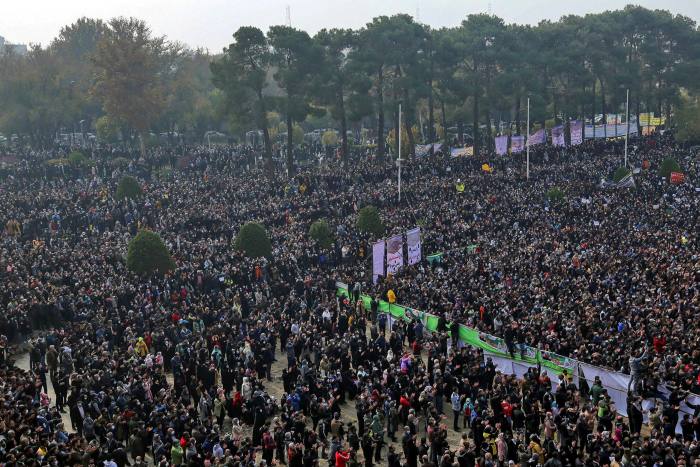Iranian water protests a ‘wake-up call’ for regime
Farmers demanding water for their crops, protesters with blood pouring down their faces and riot police shouting at them to disperse — in recent weeks the scorched riverbed at the heart of the historic city of Isfahan has been the site of Iran’s biggest ever environmental protest.
Riot police patrolled Isfahan this weekend after clearing the dried up river Zayandeh Roud of thousands of demonstrators who had made a camp there. Dozens of protesters, some chanting ‘death to the dictator’ and ‘our police, our disgrace’, have been arrested, local media reported.
Iran, an arid and semi-arid country, is struggling with decades-long drought and a rapid depletion of its water resources, a problem exacerbated by a growing population. Farmers near Isfahan are among the worst hit, arguing they have lost out as the government has prioritised providing water to cities and industry.
“Farmers know there is no water to go into the river now but this [demonstration] is a wake-up call for authorities to think of short- and long-term solutions,” said Masoud Sarrami, a senior businessman in Isfahan.
This is the latest protest to rock the Iranian regime, hit hard by sanctions, and makes clear the scale of the environmental challenge faced by the Islamic republic. As the protests grew, President Ebrahim Raisi ordered a committee to be established to look into the revival of Zayandeh Roud. Vice-president Mohammad Mokhber said the water problems would be resolved “in any means and any possible ways”. Ali Akbar Mehrabian, energy minister, has apologised to Isfahan farmers last week and promised a solution.
The situation in Isfahan is extreme.

For the past 14 months, the Zayandeh Roud river has mostly dried up, said Heshmatollah Entekhabi, a researcher of the Zayandeh Roud basin. Water was allowed into the river from the dam during two 10-day periods.
Local authorities say Zayandeh Roud dam, normally filled with rainwater and water from nearby mountains, is only 14 per cent full. Some 2m out of the 5m population of the Zayandeh Roud basin have been severely affected. Many rely on crops such as onions, potatoes, melons as well as fodder corn and alfalfa for their livelihood.
“Protests in Isfahan are not politically motivated at all but farmers have a lot of detailed information on where their water has gone,” said Fatemeh Kazemi, an environmental activist in Isfahan, indicating that local industry has been prioritised for water supplies.
Farmers’ demands are legitimate, Entekhabi said. “The government has to revive Zayandeh Roud in any possible way but until that day it must pay farmers reasonable amounts for their losses,” he added. “Instead of going to the streets which had the risks of conflicts, farmers chose the dried-out riverbed and showed to people in Iran and the world that the river is truly parched.”
In a sign of how the protests in Isfahan could escalate, thousands of people in the neighbouring Chaharmahal Bakhtiari province, where the source of Zayandeh Roud is, also took to the streets, afraid their water supply would be diverted to placate people in Isfahan. Farmers in Isfahan destroyed some water pipes to the southern city of Yazd.
The water crisis has been exacerbated by Iran’s economic crisis. Heavily sanctioned by the US after the nuclear deal collapsed, Tehran struggles to fund longer-term development plans. It also lacks access to western technologies and needs tens of billions of dollars to reform its traditional irrigation system and seek out less water-intensive crops.
At the United Nations Climate Change Conference in Glasgow last month, Iran said it would be committed to emission reductions if sanctions were lifted. Iran’s vice-president and head of the Department of the Environment, Ali Salajegheh, asked the conference “how can Iran materialise its commitments under the Paris [Climate] Accords if it is not able to receive any financial and technical help from the international community?”
Iran’s environmental activists tend to agree. “We face a dead-end whenever we suggest plans to the government which tells us in response that the country is under sanctions,” said Mohammad Darvish, a leading activist in Tehran. “A large population will be displaced in the foreseeable future. Where should they go? This is not merely Iran’s problem with its 85m population. It will affect the whole world.”
For now Isfahan is quiet. It is not clear how far farmers there are prepared to go. Some videos of the protests have gone viral. In one video, an elderly farmer said: “It was not hooligans [who beat up people]. It was the police.”
Each time there is a major protest, the regime loses a support base, said Abbas Abdi, a reformist analyst. Now they risk losing farmers, he said adding, “but it does not seem to worry anyone in the [political] system.”
Prior to the riverbed being cleared, videos of the protesters circulated on social media. “Officials should know that a war front has opened up in Isfahan,” said one middle-aged farmer in a video last week. “I warn you that you either give back the water of Zayandeh Roud or . . . you will join the dustbin of history.”